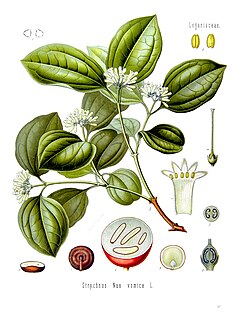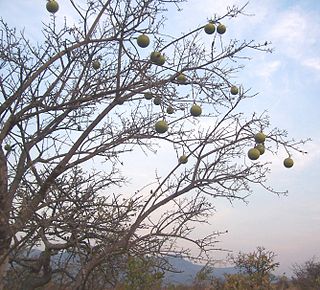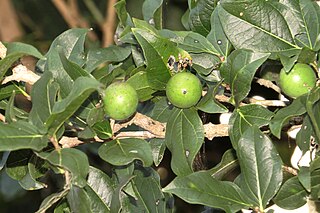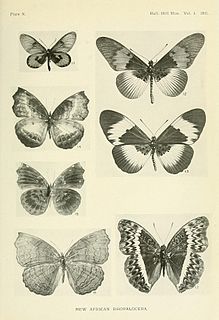
Strychnine is a highly toxic, colorless, bitter, crystalline alkaloid used as a pesticide, particularly for killing small vertebrates such as birds and rodents. Strychnine, when inhaled, swallowed, or absorbed through the eyes or mouth, causes poisoning which results in muscular convulsions and eventually death through asphyxia. While it has no known medicinal effects, in the past the convulsant effect was believed to be beneficial in small doses. The most common source is from the seeds of the Strychnos nux-vomica tree.

Strychnos nux-vomica, the strychnine tree, also known as nux vomica, poison nut, semen strychnos, and quaker buttons, is a deciduous tree native to India and to southeast Asia. It is a medium-sized tree in the family Loganiaceae that grows in open habitats. Its leaves are ovate and 2–3.5 inches (5.1–8.9 cm) in size.

The Loganiaceae are a family of flowering plants classified in order Gentianales. The family includes up to 13 genera, distributed around the world's tropics. There are not any great morphological characteristics to distinguish these taxa from others in the order Gentianales.

Strychnos is a genus of flowering plants, belonging to the family Loganiaceae. The genus includes about 100 accepted species of trees and lianas, and more than 200 that are as yet unresolved. The genus is widely distributed around the world's tropics and is noted for the presence of poisonous indole alkaloids in the roots, stems and leaves of various species. Among these alkaloids are the well-known and virulent poisons strychnine and curare.

Curare is a common name for various plant extract alkaloid arrow poisons originating from indigenous peoples in Central and South America. Used as a paralyzing agent for hunting and for therapeutic purposes, Curare only becomes active by a direct wound contamination by a poison dart or arrow or via injection. These poisons function by competitively and reversibly inhibiting the nicotinic acetylcholine receptor (nAChR), which is a subtype of acetylcholine receptor found at the neuromuscular junction. This causes weakness of the skeletal muscles and, when administered in a sufficient dose, eventual death by asphyxiation due to paralysis of the diaphragm. Curare is prepared by boiling the bark of one of the dozens of plant alkaloid sources, leaving a dark, heavy paste that can be applied to arrow or dart heads. Historically, curare has been used as an effective treatment for tetanus or strychnine poisoning and as a paralyzing agent for surgical procedures.
Snakewood is a common name of several different plants:

Strychnos spinosa, the Natal orange, is a tree indigenous to tropical and subtropical Africa. It produces, sweet-sour, yellow fruits, containing numerous hard brown seeds. Greenish-white flowers grow in dense heads at the ends of branches. The fruits tend to appear only after good rains. It is related to the deadly Strychnos nux-vomica, which contains strychnine. The smooth, hard fruit are large and green, ripen to yellow colour. Inside the fruit are tightly packed seeds, which may be toxic, surrounded by a fleshy, brown, edible covering. Animals such as baboon, monkeys, bushpig, nyala and eland eat the fruit. The leaves are a popular food source for browsers such as duiker, kudu, impala, steenbok, nyala and elephant.
Strychnos chromatoxylon is a species of plant in the Loganiaceae family. It is found in Cameroon, Central African Republic, and Ivory Coast.
Strychnos elaeocarpa is a species of plant in the Loganiaceae family. It is endemic to Cameroon. Its natural habitat is subtropical or tropical moist lowland forests. It is threatened by habitat loss.
Strychnos mellodora is a species of plant in the Loganiaceae family. It is found in Kenya, Mozambique, Tanzania, and Zimbabwe.
Strychnos millepunctata is a species of shrub or small tree in the Loganiaceae family. It is endemic to Côte d'Ivoire and grows in the lowland Eastern Guinean forests where it is threatened by habitat loss. S. millepunctata has been investigated for pharmacological properties of its alkaloids.
Strychnos staudtii is a species of plant in the Loganiaceae family. It is found in Cameroon and Gabon. Its natural habitat is subtropical or tropical moist lowland forests. It is threatened by habitat loss.
Strychnos tetragona is a species of plant in the Loganiaceae family. It is endemic to Sri Lanka.

Strychnos potatorum also known as clearing-nut tree is a deciduous tree which has height up to 40 feet. The seeds of the tree are commonly used in traditional medicine as well as for purifying water in India and Myanmar.

Ariadne albifascia, the white-banded castor, is a butterfly in the family Nymphalidae.The Biblidinae are a subfamily of butterflies with over 350 species worldwide, the vast majority of which are Neotropical. In the Afrotropical region there 30 species, in the genera Byblia, Ariadne, Eurytela, Neptidopsis, Sevenia and Mesoxantha. It is found in Sierra Leone, Liberia, Ivory Coast, Ghana, Nigeria, Cameroon, the Republic of the Congo, the Central African Republic, the Democratic Republic of the Congo and western Uganda. The habitat consists of forests, especially open degraded habitats.

Neptidopsis ophione, the scalloped false sailer or scalloped sailer, is a butterfly in the family Nymphalidae. It is found in Guinea, Sierra Leone, Liberia, Ivory Coast, Ghana, Togo, Benin, Nigeria, Cameroon, Equatorial Guinea, Gabon, the Republic of the Congo, Angola, the Democratic Republic of the Congo, Uganda, Sudan, Ethiopia, Kenya, Tanzania, Malawi, Zambia, Mozambique and Zimbabwe. The habitat consists of forest edges, secondary forest and dense woodland.

Strychnos madagascariensis, the black monkey orange, is an African tropical and sub-tropical tree belonging to the Loganiaceae family. It is a tree with characteristically large fruit but can confused with some other species of the genus.

Strychnos usambarensis is a shrub or small tree up to 15m tall or a 70m long liane of Sub-Saharan Africa, occurring in forest and woodland, mountain ravines and coastal bush, often on rocky slopes and named for the Usambara Mountains of Tanzania. The species is found from Guinea east to Nigeria, from Congo east to Kenya and south to kloofs of the Magaliesberg of South Africa. Bantu tribes from Rwanda and Tanzania produce an arrow poison from the root bark and leaves of this species, sometimes combining it with extracts from other plants.

Strychnos toxifera, called bush rope and devil doer, is a species of flowering plant in the genus Strychnos, native to Costa Rica, Panama, Colombia, Ecuador, Venezuela, the Guianas, Brazil, and Bolivia. It is the principle source of calabash or gourd curare.











